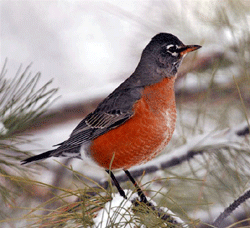Robins All Ears
Air Date: Week of March 24, 2006

The American Robin (Photo: Karen L. Sirna ©)
You may have noticed the way robins jauntily cock their heads as they hop along the ground this time of year. Turns out they're listening, very carefully, for the movements of sleepy springtime worms. Jeff Rice reports.
Transcript
GELLERMAN: Nothing says 'spring is here' quite like...the sound of worms. You hadn't noticed? The robins have. As part of the Western Soundscape Project, Jeff Rice reports.
RICE: Take a listen to your lawn for a minute, just beneath the soil.
[SOUND OF WORMS]
RICE: Those are earthworms.
MONTGOMERIE: The worms are moving through the soil, and the little particles of sand are hitting against each other.
RICE: That's Dr. Bob Montgomerie of Queen's University in Canada. He made these recordings. Chances are you've never heard earthworms before.
[WORM SOUND CONTINUES]
MONTGOMERIE: No, they're extremely quiet. The only way we were able to record them was to put them in a chamber, called an anechoic chamber, and use a very high-sensitivity directional microphone – one that would pick up a human's voice at a couple of hundred meters –and pointing it right at the soil about centimeter away from the worm.
RICE: So, you might think that such a very, very quiet sound would be pretty insignificant. Hardly a sound at all, really. But consider this. Next time you see a robin on your lawn...
[QUICK ROBIN CHIRPS]

The American Robin (Photo: Karen L. Sirna ©)
MONTGOMERIE: Well, way back into the 1800s, people writing about robins have thought that they were listening when they were foraging on lawns. You see a robin hopping along, and then it cocks its head. And lots of people, lots of naturalists, have written popular articles saying that they were listening for worms.
RICE: Nothing was scientifically proven until several years ago when Dr. Montgomerie and a colleague were taking a break from their usual fieldwork – Dr. Montgomerie studies, among other things, reproductive behavior in birds – and they noticed robins cocking their heads toward the ground.
MONTGOMERIE: You know, it really looks like they're cocking their head and listening.
RICE: They decided to answer the question once and for all, and devised a series of experiments.
MONTGOMERIE: Well, we caught a few robins. We were working on them anyway. We were studying the way that they look after their babies and choose mates. And so we grabbed a couple and put them in an outdoor aviary that we had at our field station. And then we designed a careful experimental protocol to try to eliminate each of the sensory modes in order.
RICE: They tested everything short of robin ESP. They hid worms behind barriers. Eliminated the possibilities of smell and touch. But just based on hearing, robins:
MONTGOMERIE: Found the worms with no problem.
[ROBIN CHIRPS]
RICE: The two scientists published their findings in the journal Animal Behaviour. Just how a robin is able to hear something as quiet as an earthworm is still unknown, but they are not the only birds that can locate food this way. Magpies are also known to locate scarab beetle grubs in the ground through hearing. For Living on Earth, I'm Jeff Rice.
Living on Earth wants to hear from you!
Living on Earth
62 Calef Highway, Suite 212
Lee, NH 03861
Telephone: 617-287-4121
E-mail: comments@loe.org
Newsletter [Click here]
Donate to Living on Earth!
Living on Earth is an independent media program and relies entirely on contributions from listeners and institutions supporting public service. Please donate now to preserve an independent environmental voice.
NewsletterLiving on Earth offers a weekly delivery of the show's rundown to your mailbox. Sign up for our newsletter today!
 Sailors For The Sea: Be the change you want to sea.
Sailors For The Sea: Be the change you want to sea.
 The Grantham Foundation for the Protection of the Environment: Committed to protecting and improving the health of the global environment.
The Grantham Foundation for the Protection of the Environment: Committed to protecting and improving the health of the global environment.
 Contribute to Living on Earth and receive, as our gift to you, an archival print of one of Mark Seth Lender's extraordinary wildlife photographs. Follow the link to see Mark's current collection of photographs.
Contribute to Living on Earth and receive, as our gift to you, an archival print of one of Mark Seth Lender's extraordinary wildlife photographs. Follow the link to see Mark's current collection of photographs.
 Buy a signed copy of Mark Seth Lender's book Smeagull the Seagull & support Living on Earth
Buy a signed copy of Mark Seth Lender's book Smeagull the Seagull & support Living on Earth

